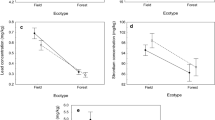Abstract
The contribution of soils to animal biology through the soil’s effect on the ecosystem is an important concept in ecology. Zinc, Fe, and Na contents were determined in autumnal collections of hair of fawn white-tailed doe deer (Virginianus odocoileus) from two areas of contrasting soil productivity. The area-weighted soil productivity of one area was 40 compared with 79 for the other area. Hair collections were made in each of 8 consecutive years. The mean difference in dressed weight of fawn does collected from these areas in late autumn over 4 yr amounted to 7.2 kg. Some of this weight difference was presumed to be accounted for by a difference in the level of mineral nutrition because the amount of forage was not limiting in either area. Considering the total sample of 8 yr, the mean contents of Zn were 96 and 98, of Fe were 42 and 45, and of Na were 38 and 36 mg/kg for the respective areas. None of the elements was significantly different each year over the observation period. In 3 yr, at least one of the elements differed, and in 1 yr all three differed. The contents of the elements were not related to April through August precipitation, which was considered a measure of plant-available water thought to be important in mineral absorption by forage vegetation. Zinc was significantly different in 29 of the 56 between-year comparisons within areas; Fe differed in 2 and Na in 14 comparisons. The site of collection of the doe was known within a 2.6-km2 area for about 80% of the samples for one of the areas and 90% for the other; therefore, either a soil series or soil association could be identified with the deer. Soils were grouped into two categories in each sampling area; the groupings reflected the intensity of weathering and leaching in one area, and in the other case where soil weathering was not as well developed, substantial soil taxonomic contrast related to grass or deciduous tree vegetation associated with soil development. Only Fe in hair from does collected in the more intensively weathered soil area was significantly different, perhaps reflecting higher levels of plant-available Fe made available to plants because of breakdown of Fe-bearing minerals.
Similar content being viewed by others
References
A. W. Franzmann, A. Flynn, and P. D. Arneson, Alaskan moose hair element values and variability, Comp. Biochem. Physiol. 57A, 299–306 (1977).
S. D. Schemnitz, Spectrographic analysis of mineral elements in deer and moose hair from Maine, Res. Life Sci. (Univ. Maine, Orono.) 24, 1–11 (1977).
R. L. Jones and H. P. Weeks, Jr., Calcium, magnesium, and potassium in hair of deer from areas of contrasting soil productivity, Biol. Trace Element Res. 62, 155–166 (1998).
H. P. Weeks, Jr. and C. M. Kirkpatrick, Adaptations of white-tailed deer to naturally occurring sodium deficiencies, J. Wildl. Manage. 40, 610–625 (1976).
G. Klaus and B. Schmid, Geophagy at natural licks and mammal ecology: a review, Mammalia 62, 481–497 (1976).
A. L. Kenworthy, E. J. Miller, and W. T. Mathis, Nutrient-element analysis of fruit tree leaf samples by several laboratories, Proc. Am. Soc. Hort. Sci. 67, 16–21 (1956).
SAS Institute Inc., SAS® User’s Guide: Statistics, Version 5, SAS Institute Inc., Cary, NC (1985).
R. L. Jones and H. C. Hanson, Mineral licks, Geophagy, and Biogeochemistry of North American Ungulates, Iowa State University Press, Ames (1985).
Author information
Authors and Affiliations
Rights and permissions
About this article
Cite this article
Jones, R.L. Zinc, iron, and sodium in hair of deer from areas of contrasting soil productivity. Biol Trace Elem Res 86, 217–226 (2002). https://doi.org/10.1385/BTER:86:3:217
Received:
Accepted:
Issue Date:
DOI: https://doi.org/10.1385/BTER:86:3:217




